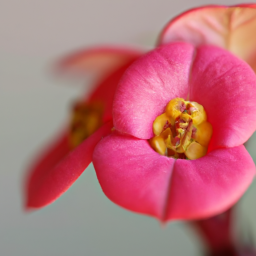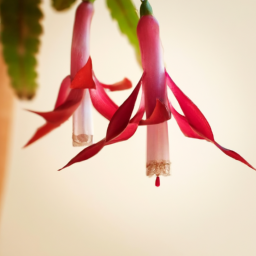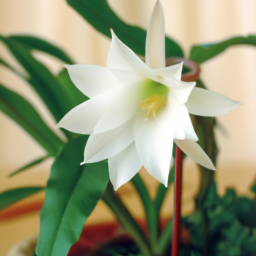
Are you looking to add some color and life to your home? Flowering house plants are the perfect solution! Not only do they brighten up any room, but they also provide a touch of nature indoors. Whether you’re a seasoned plant parent or just starting out, flowering house plants are a great addition to any space. In this blog post, we’ll explore the different types of flowering house plants available, as well as tips for caring for them to ensure they bloom beautifully all year round. So, grab your watering can and let’s dive into the wonderful world of flowering house plants!
Benefits of Flowering House Plants in Home Decor
Enhancing Aesthetics
Flowering house plants are a great way to add a pop of color and life to any room in your home. Whether you choose a vibrant orchid or a delicate African violet, these plants can instantly brighten up your space and create a more inviting atmosphere. The variety of colors, shapes, and sizes available in flowering house plants make it easy to find the perfect plant to complement your home decor.
In addition to adding visual appeal, flowering house plants can also help improve the overall ambiance of a room. The presence of plants has been shown to reduce stress and anxiety, making them a great addition to any room where you want to create a relaxing and peaceful environment. By incorporating flowering house plants into your home decor, you can create a space that is not only beautiful but also calming and rejuvenating.
Furthermore, flowering house plants can serve as a focal point in a room, drawing the eye and adding interest to the space. Whether placed on a mantel, a side table, or a windowsill, a flowering house plant can become a conversation piece and a unique element of your home decor.
Improving Air Quality
One of the lesser-known benefits of flowering house plants is their ability to improve indoor air quality. Plants naturally absorb carbon dioxide and release oxygen through the process of photosynthesis, helping to purify the air in your home. In addition to releasing oxygen, some flowering house plants, such as peace lilies and spider plants, are also known for their ability to remove toxins such as formaldehyde, benzene, and trichloroethylene from the air.
By incorporating flowering house plants into your home decor, you can create a healthier living environment for you and your family. Improved air quality can lead to better respiratory health, reduced allergies, and a general sense of well-being. In addition, the presence of plants in your home can help to regulate humidity levels, reducing the risk of respiratory problems and dry skin.
When choosing flowering house plants for their air-purifying properties, be sure to consider the size of the plant and its care requirements. Some plants are more effective at purifying the air than others, so it’s important to do your research and choose plants that will thrive in your home environment.
Promoting Well-being
Flowering house plants can have a positive impact on your overall well-being by providing a connection to nature and a sense of tranquility. Studies have shown that spending time around plants can reduce stress, improve mood, and increase productivity. By incorporating flowering house plants into your home decor, you can create a space that promotes relaxation and mental clarity.
In addition to their psychological benefits, flowering house plants can also have physical health benefits. The act of caring for plants can be a therapeutic activity that promotes mindfulness and reduces anxiety. Whether you’re watering, pruning, or repotting your plants, the act of tending to them can be a calming and meditative practice.
Overall, flowering house plants are a versatile and valuable addition to any home decor. From enhancing aesthetics to improving air quality and promoting well-being, these plants offer a wide range of benefits that can enhance your living space and enrich your daily life.

Top 10 Low-Maintenance Flowering House Plants for Beginners
Choosing the Right Flowering House Plants
When it comes to choosing flowering house plants for beginners, it’s important to consider the level of maintenance required. Some plants are more high maintenance and may not be suitable for beginners who are just starting out. Here are 10 low-maintenance flowering house plants that are perfect for beginners:
1. Peace Lily: Peace lilies are known for their beautiful white flowers and easy care requirements. They thrive in low light conditions and only need to be watered once a week.
2. African Violet: African violets are small, colorful plants that bloom year-round. They prefer indirect light and should be watered when the soil feels dry to the touch.
3. Spider Plant: Spider plants are easy to care for and produce small white flowers. They thrive in bright, indirect light and only need to be watered when the soil is dry.
4. Kalanchoe: Kalanchoes are succulent plants that produce clusters of colorful flowers. They prefer bright, indirect light and should be watered sparingly.
5. Orchid: Orchids are elegant flowering plants that come in a variety of colors and patterns. They prefer bright, indirect light and should be watered once a week.
6. Christmas Cactus: Christmas cacti are popular flowering plants that bloom in the winter. They prefer bright, indirect light and should be watered when the soil feels dry.
7. Begonia: Begonias are colorful plants that come in a variety of shapes and sizes. They prefer bright, indirect light and should be watered when the soil feels dry.
8. Geranium: Geraniums are classic flowering plants that bloom in vibrant colors. They prefer bright, direct light and should be watered when the soil feels dry.
9. Anthurium: Anthuriums are tropical plants that produce bright red flowers. They prefer bright, indirect light and should be watered when the soil feels dry.
10. Pothos: Pothos plants are easy to care for and produce small white flowers. They thrive in low light conditions and only need to be watered when the soil is dry.
Caring for Your Flowering House Plants
Once you’ve chosen the right flowering house plants for your space, it’s important to know how to care for them properly. Here are some general tips for caring for your flowering house plants:
– Watering: Most flowering house plants prefer to be watered when the top inch of soil feels dry to the touch. Overwatering can lead to root rot, so it’s important to let the soil dry out between waterings.
– Light: Different flowering house plants have different light requirements, so it’s important to place them in the right spot. Most plants prefer bright, indirect light, but some can thrive in low light conditions.
– Temperature: Flowering house plants generally prefer temperatures between 65-75 degrees Fahrenheit. Avoid placing them near drafts or heaters, as extreme temperatures can stress the plants.
– Fertilizing: Flowering house plants benefit from regular fertilization during their growing season. Use a balanced fertilizer diluted to half strength every 4-6 weeks to promote healthy growth and blooming.
– Pruning: Regular pruning can help promote new growth and keep your plants looking their best. Remove dead or yellowing leaves and spent flowers to encourage new blooms.
Troubleshooting Common Issues
Even low-maintenance flowering house plants can run into problems from time to time. Here are some common issues you may encounter and how to troubleshoot them:
– Yellowing leaves: Yellowing leaves can be a sign of overwatering, underwatering, or nutrient deficiencies. Check the soil moisture and adjust your watering schedule accordingly. You may also need to fertilize your plants to provide them with the necessary nutrients.
– Drooping leaves: Drooping leaves can be a sign of underwatering or root rot. Check the soil moisture and adjust your watering schedule if needed. If root rot is suspected, repot the plant in fresh soil and trim any affected roots.
– Pests: Common pests that can affect flowering house plants include spider mites, aphids, and mealybugs. Use a gentle insecticidal soap or neem oil to treat infestations, and regularly inspect your plants for signs of pests.
By following these tips and choosing low-maintenance flowering house plants, beginners can enjoy the beauty of blooming plants in their homes with minimal effort. Remember to observe your plants regularly and adjust your care routine as needed to keep them healthy and thriving.

How to Care for Flowering House Plants: Tips and Tricks for Success
Understanding the Basics
When it comes to caring for flowering house plants, there are a few key factors to keep in mind. First and foremost, it’s important to understand the specific needs of the plant you are caring for. Different flowering house plants require different levels of light, water, and humidity, so be sure to do your research before bringing a new plant into your home.
In general, most flowering house plants prefer bright, indirect light. This means placing them near a window where they can receive plenty of sunlight, but not direct sunlight that could potentially burn their leaves. If you notice your plant starting to lean towards the light, be sure to rotate it regularly to ensure even growth.
When it comes to watering, it’s important to strike a balance. Overwatering can lead to root rot, while underwatering can cause the plant to wilt and die. The best way to determine when your plant needs water is to stick your finger into the soil. If it feels dry to the touch, it’s time to water. Be sure to also provide adequate drainage to prevent water from pooling at the bottom of the pot.
Humidity is another important factor to consider when caring for flowering house plants. Most plants prefer a humid environment, so be sure to mist them regularly or place a humidifier nearby. You can also group plants together to create a microclimate that mimics their natural habitat.
Feeding and Pruning
In addition to light, water, and humidity, flowering house plants also require regular feeding to thrive. You can use a balanced liquid fertilizer once a month during the growing season to provide your plants with the nutrients they need to produce healthy blooms. Be sure to follow the instructions on the packaging and avoid overfertilizing, as this can lead to nutrient burn.
Pruning is another important aspect of caring for flowering house plants. Regularly removing dead or yellowing leaves can help prevent the spread of disease and encourage new growth. You can also prune back leggy stems to promote a bushier, more compact plant. Be sure to use clean, sharp scissors to make clean cuts and avoid damaging the plant.
Propagation is another way to care for flowering house plants and ensure their continued success. You can propagate many plants by taking stem or leaf cuttings and rooting them in water or soil. This can help you create new plants to share with friends or expand your collection.
Troubleshooting Common Issues
Despite your best efforts, you may encounter some common issues when caring for flowering house plants. Yellowing leaves can be a sign of overwatering, while brown, crispy leaves may indicate underwatering. Wilting can also be a sign of stress, so be sure to check the soil moisture and adjust your watering schedule accordingly.
Pests can also be a problem for flowering house plants, so be sure to keep an eye out for signs of infestation. Common pests include spider mites, aphids, and mealybugs, which can be treated with insecticidal soap or neem oil. Be sure to isolate any infested plants to prevent the pests from spreading to other plants.
Finally, be patient and observant when caring for flowering house plants. It may take some trial and error to find the right balance of light, water, and humidity for your plants, but with time and care, you can create a thriving indoor garden that brings beauty and joy to your home.
Key Takeaways of this article
If you’re looking to add some greenery and color to your home, flowering house plants are a fantastic option. These plants not only brighten up your space, but they also bring a touch of nature indoors. From vibrant orchids to delicate African violets, there are countless options to choose from when it comes to flowering house plants.
One of the best things about flowering house plants is that they come in a wide range of shapes, sizes, and colors, making it easy to find the perfect plant to suit your space and style. Whether you have a sunny windowsill or a shady corner, there’s a flowering house plant that will thrive in your home. Plus, many flowering house plants are relatively low-maintenance, making them a great option for both experienced and novice plant owners. So why not bring a little bit of the outdoors inside with a beautiful flowering house plant?
Q&A Corner:
Q1: What are some popular flowering house plants?
A1: Some popular flowering house plants include orchids, African violets, peace lilies, and begonias. These plants add color and beauty to indoor spaces.
Q2: How can I care for flowering house plants?
A2: To care for flowering house plants, make sure they receive adequate sunlight, water them regularly (but not too much), and provide proper drainage. You may also need to fertilize them occasionally to promote healthy growth and blooming.
Q3: Can flowering house plants thrive in low light conditions?
A3: While most flowering house plants prefer bright, indirect light, some varieties like peace lilies and African violets can still thrive in low light conditions. Just be sure to adjust watering and care routines accordingly.
Q4: How often should I water my flowering house plants?
A4: The frequency of watering your flowering house plants will depend on factors like the plant type, size of the container, and environmental conditions. As a general rule, it’s best to water when the top inch of soil feels dry to the touch.
Q5: Do flowering house plants require any special care during blooming season?
A5: During blooming season, flowering house plants may benefit from a bit of extra care to help prolong the blooming period. This may include deadheading spent flowers, providing a balanced fertilizer, and ensuring they receive adequate sunlight and water.
Emily Bloomfield is an interior designer and horticulturist specializing in incorporating indoor plants into interior spaces. With a background in both design and plant science, Emily offers a unique perspective on creating harmonious living environments through the synergy of greenery and aesthetics. Her creative ideas and innovative solutions make her a sought-after authority in the field.


